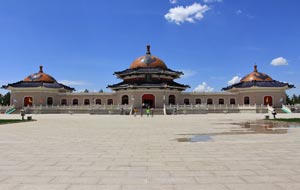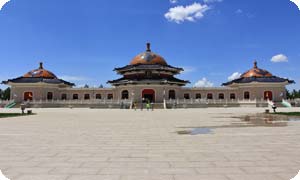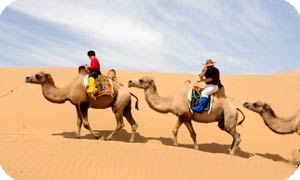 The Genghis Khan Mausoleum was built in the year 1954 and is a major attraction in Inner Mongolia.Although there have been several disputes over the authenticity of this monument, it still attracts thousands of people each month and is now considered to be a holy location.
The Genghis Khan Mausoleum was built in the year 1954 and is a major attraction in Inner Mongolia.Although there have been several disputes over the authenticity of this monument, it still attracts thousands of people each month and is now considered to be a holy location.
Genghis Khan is a Mongolian hero. He reunified the chaotic Inner Mongolia prairie and led his people to be a great civilization and made great contributions to the founding of the powerful Yuan Dynasty (1271-1368) and the unification of China which enhanced greatly the interactions of the peoples of China. Due to this great feat, he was named ‘Genghis Khan’ by Mongolian tribes, meaning ‘powerful king’ in Mongolian. Today, Genghis Khan is still worshipped and remembered by his people.
Most people, however, believe that this mausoleum is not where he was really buried but is rather a gathering place for Mongolians to offer sacrifice. Whether this is true or not, the mausoleum remains a sacred place with great significance for Mongolian people.
The Main Structure
The three grand halls make the main structure of this mausoleum. The halls are shaped like the traditional Mongolian yurts. The three halls are connected by a corridor. The Main Hall is in the middle and is also known as the Memorial Hall. In this hall stands a beautiful marble statue of Genghis Khan in white. The statue is more than 4 meters tall. Behind this statue is a map of the Yuan Dynasty’s vast territory.
West Hall and East Hall
The East and the West Halls are located on each side of this Main Hall. The East Hall contains the coffin of Genghis Khan’s wife as well as the fourth son. The West Hall exhibits the arms of Genghis Khan. The corridors are home to beautiful frescos that depict his life as well as the many notable deeds of Kubla Khan, his grandson who was just as noteworthy
There are biers behind the mausoleum’s main hall which are covered with yellow satin. These are believed to be the coffins of the hero as well as his three wives. Two other coffins are that of his brothers. Other than the mausoleum itself, tourists can also get a taste of Mongolian barbecue and get to see the local horse and dance performances. Tourists can also participate in wrestling, arrow shooting, horse riding and dancing.
The Ceremonies
Four times each year various ceremonies are organized in the area and are dedicated to Genghis Khan. Various Mongolian monks attend these ceremonies along with Daur Minority people. The ceremonies mostly take place in its Main Hall. Some of the rites performed include burning butter lamps, presenting a whole, roasted lamb and chanting from the holy scriptures. Tourists can get to see the rites and perform in various activities to show respect.
Recommended Guilin Tours Including a Visit of Dazhao Temple
|
|
|
Service:English speaking tour guide + vehicle + entrance fees
|











